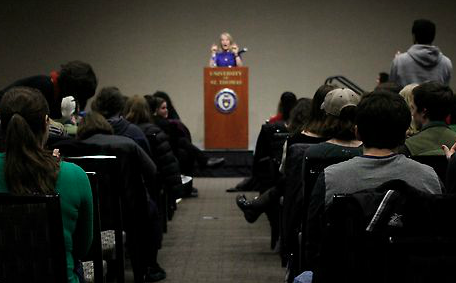When Piper Kerman arrived at prison, she was given a number, a uniform and a kitten sticker.
The number and uniform were meant to take away her individuality and humanity, but the sticker from a fellow inmate, and the kindness of others, helped her get those elements back.
“The last thing that I expected on my first day of prison was to experience kindness at the hands of the other prisoners, but that’s exactly what happened,” Kerman said. “That was such a powerful signal to me in that environment.”
Kerman, the author of the book “Orange is the New Black: My Year in a Women’s Prison,” gave a speech on her experience while incarcerated and her work as an advocate for prisoners on Wednesday night at the Woulfe Alumni Hall. Kerman spoke about issues in her book, including race, class and gender.
Kerman explained that most people have a stereotypical view of prisons and prisoners as violent people and places. She said she wrote her book to give a better understanding of the people in prison.
“I hoped that by writing about my own experience, the things I experienced and I witnessed, during that year of incarceration that the reader might come away with a different idea about who is in prison,” she said.
Freshman Kelly Ancel said Kerman brought up views of prisoners that she had never considered.
“They’re a lot less violent; they’re a lot more friendly; and it’s kind of nice to know that she’s advocating for those people that deserve that second chance,” Ancel said.
Women, for example, do not correspond to the typical image of inmates, Kerman said. Yet, she said, the incarceration of women has increased about 800 percent in the last 30 years, and the United States houses one-third of the world’s female prisoners. According to Kerman, the majority of these women are nonviolent offenders.
Kerman said the large number of women in prison, combined with mostly male guards, creates a dangerous power dynamic.
“In every facility that holds women and girls, there are incidences of sexual exploitation and sexual abuse,” she said.
Kerman also spoke about the influence of race and class on the incarceration of her fellow inmates. She said these two factors play a large role in determining who will be sent to prison, although they are not a profile of who actually commits crimes.
“I could not draw the conclusion that their crimes could possibly have been so much worse than my own,” Kerman said. “I had been treated very different by the criminal justice system than they had because of socioeconomics and in some cases because of the color of their skin.”
Freshman Yasmin Adam said in addition to being a fan of the Netflix series based on Kerman’s book, one of her professors has discussed the representation of race, class and gender in the show.
“My sociology teacher also discussed about how it would portray deviance and the race, class and gender issue,” Adam said. “I thought it would be really cool to see it from the actual person’s point of view.”
According to Kerman, this points to the disparities and misuse of the United States criminal justice system.
“The criminal justice system is still being used as a tool of control over communities of color,” she said. “It’s time for the criminal justice system to catch up.”
Junior Hannah Wagener said she agreed with Kerman’s view of the criminal justice system.
“Our justice system is in need of help,” Wagener said. “We need to reform the way that we look at crime and those who committed crime, especially in minorities.”
The themes of race, class, gender and power are conveyed on screen in the Netflix adaption of Kerman’s book. Kerman said the show accurately conveys the details of prison life and the main issues from her book, even if she’s not exactly like the character Piper Chapman.
“I’m delighted by what they have accomplished,” Kerman said.
Rebecca Mariscal can be reached at mari2162@stthomas.edu.



